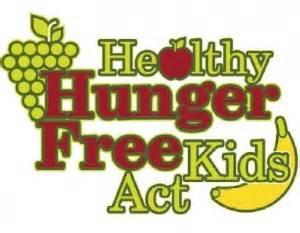 Congress passed the Hunger-Free Kids Act in 2010 with bipartisan support to help ensure every American child had access to the nutrition they need to grow into healthy adults. One goal of the law was to help reduce America’s childhood obesity epidemic and reduce health risks for America’s children by helping schools across the country produce balanced meals so children had access to healthy foods during the school day. USDA based the new school meal standards on independent, expert recommendations from the Institute of Medicine to ensure kids are being fed healthy food while they are at school.
Congress passed the Hunger-Free Kids Act in 2010 with bipartisan support to help ensure every American child had access to the nutrition they need to grow into healthy adults. One goal of the law was to help reduce America’s childhood obesity epidemic and reduce health risks for America’s children by helping schools across the country produce balanced meals so children had access to healthy foods during the school day. USDA based the new school meal standards on independent, expert recommendations from the Institute of Medicine to ensure kids are being fed healthy food while they are at school.
Results of the Healthy-Hunger Free Kids Act school meals provision to date include:
- Kids are eating more fruits and vegetables as a result of updated standards. A recent Harvard study has concluded that, under the updated standards, kids are now eating 16 percent more vegetables and 23 percent more fruit at lunch.
- Over 90 percent of schools report that they are successfully meeting the updated nutrition standards. Students across the country are experiencing a healthier school environment with more nutritious options. The new meals are providing children more whole grains, fruits and vegetables, lean protein and low-fat dairy, as well as less sugar, fat, and sodium.
- School lunch revenue is up. Despite concerns raised about the impact of new standards on participation and costs, a USDA analysis suggests that in the first year of implementing updated meal patterns, schools saw a net nationwide increase in revenue from school lunches of approximately $200 million. This includes the annual reimbursement rate adjustments, as well as increased revenue from paid meals and the additional 6 cents per meal for schools meeting the new meal standards.
- Healthy food standards have not increased food waste. While reducing plate waste at schools, homes and workplaces continues to be a priority for USDA, a recent study by the Harvard School of Public Health showed that new school meal standards did not result in increased food waste.
- Participation is increasing substantially in many areas of the country. USDA has received reports from many schools indicating a positive response to healthier offerings and increased participation. Examples include Los Angeles, Dallas, and some of Florida’s largest school districts. In fact, Los Angeles Unified-one of the nation’s largest school districts-has seen a 14% increase in participation under the new meal standards. As more kids and schools continue to successfully make the transition to the new standards, USDA expects participation to keep climbing.
- HHFKA has led to participation increases within many schools. The Community Eligibility Provision (CEP) under the HHFKA has been successfully implemented in almost 4,000 schools in early adopting States. More than 600 school districts across 11 States have at least one school participating in CEP. The evaluation results demonstrate that participating schools were able to increase participation in their meals programs, and as well as experience revenue gains and decreased administrative costs.
- Virtually all schools continue to participate. Data from states indicated very few schools (only 0.15% of schools nationwide) reported dropping out of the programs due to struggles over providing kids healthy food. State agencies reported that the schools no longer participating in the NSLP were mainly residential child care institutions and smaller schools with very low percentages of children eligible for free and reduced price meals.
- USDA has and will continue to listen to stakeholders and provide guidance and flexibilities, as appropriate, to help schools and students adapt to the updated requirements. Early in the implementation process for school meals, when schools asked for flexibility to serve larger servings of grains and proteins within the overall calorie caps, USDA responded. In January of this year, that flexibility was made permanent. USDA is also phasing other requirements in over the next several years. And hearing schools concerns on the lack of availability of whole grain pasta, USDA is allowing schools that have demonstrated difficulty in obtaining adequate whole grain pasta to use traditional pastas for an additional two years while industry works to create better whole grain pasta products.
-
USDA is helping schools encourage kids to choose new healthier options. Most recently, the Department announced $5.5 million in new grants to support Smarter Lunchrooms, a broad toolkit of easy-to-implement, low-cost, evidence-based strategies that increase consumption of healthier foods and decrease plate waste.
- USDA is supporting numerous training sessions in conjunction with our partners to help schools implement the updated meal standards and prepare for Smart Snacks. USDA has completed seven sessions with various audiences since the rule was published, and additional training is planned for the rest of the year. The Department has made in-person trainings at 16 school professional organization meetings and have tree more scheduled this spring and summer.
-
USDA is supporting implementation of the updated school meals standards and new Smart Snacks standards through a variety of additional methods.

